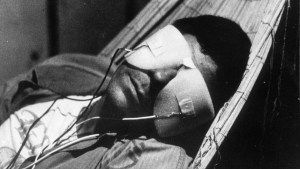1995 was the home of many now-revered movies. Toy Story, the world’s first fully computer-animated feature, hit theaters that Thanksgiving. Cult favorite blockbuster Batman Forever dominated multiplexes that summer. Oscar darling Apollo 13 was also a summer 1995 smash, while GoldenEye would revive the James Bond franchise for a new era. It was a glorious year for movies in many respects, but there was also a tremendous box office flop that would have immense ripple effects on the global film industry.
Videos by ComicBook.com
Ironically, that feature materialized as the 12th biggest movie of 1995 at the domestic box office. When you cost as much as Kevin Costner’s infamous Waterworld, though, outgrossing fellow 1995 movies like Braveheart, Get Shorty, and The Bridges of Madison County wasn’t anywhere near enough to turn a profit.
What Went Wrong With Waterworld?

The most obvious answer for what went wrong with Waterworld is you don’t shoot movies either on the ocean or in giant tanks full of water. Going this route for costly blockbusters just seems to produce infinitely more trouble than it’s worth. Some of the priciest movies in history, namely the third and fourth Pirates of the Caribbean movies and Avatar: The Way of Water, incurred tremendous costs by telling stories involving the open seas. Unless you’ve got James Cameron’s box office track record, scoring profitability with a waterbound blockbuster is almost impossible.
1995’s Waterworld was another example of this trend, with its gargantuan $175-million costs. While today that would just be the catering budget for Avengers: Doomsday, it was by far the biggest budget ever for a movie at the time. For comparison’s sake, a year earlier, True Lies became the first movie in history to have a $100+-million budget (its reported budget was $100 million). Adjusted for inflation, Waterworld cost $355 million, a higher budget than Avatar: The Way of Water or Mission: Impossible – The Final Reckoning.
What on Earth happened to boost the budget so high? Shooting the feature in either natural elements or massive water tanks meant that Waterworld was at the mercy of the elements. That ensured pricey set pieces, not to mention countless extras, were constantly delayed and jeopardized by uncontrollable elements. Shooting going comically over schedule, and difficulties between Costner and director Kevin Reynolds, further exacerbated costs. It was a nightmare production that ensured Waterworld sailed towards budgetary waters unheard of for big blockbusters at the time.
The Long-Lasting Consequences of Waterworld

If only Waterworld had featured a more reasonable budget or even a price tag more reminiscent of True Lies. Its $264.2-million global total was, on its own terms, genuinely respectable for an original summer blockbuster circa 1995. However, with a $175-million price, this worldwide haul was nowhere near enough to make the boondoggle profitable. Waterworld went down as one of the decade’s biggest box-office flops. Subsequently, Waterworld became a punchline, and Hollywood didn’t go anywhere near projects with similar plotlines or tones.
For Kevin Costner, the feature was the start of a box-office cold streak that wouldn’t get broken for decades. 1997’s The Postman, which cost $80 million to make yet only made $30 million globally, continued the Waterworld trend of Costner getting attached to excessively costly epics that critics and audiences alike rejected. Infamously, Horizon: An American Saga – Chapter One cratered in its theatrical run in June 2024. Not only was this Western pricey on its own merits, but its failure immediately jeopardized three planned sequels. It was another costly mess that Costner was at the center of.
Though he’d never again get top billing on a movie as expensive as Waterworld, this 1995 title did foreshadow the costly misfires defining Costner’s post-1994 career. To boot, it also signaled that the days of him starring in multiple consecutive hits like Robin Hood: Prince of Thieves, JFK, and The Bodyguard were over. It was a turning point for Costner and not in the best way possible. Oh, and of course, Waterworld’s failure ensured Hollywood was steering clear of waterbound movies for the foreseeable future.
That’s partially why 2003’s Pirates of the Caribbean: The Curse of the Black Pearl was initially viewed as an inevitable box-office flop before its release. Unlike Costner-led blockbusters, watery tentpoles would get redemption with Black Pearl and The Way of Water. And at least this legendary box office flop from 1995 inspired a Universal theme park stunt show that’s still dazzling audiences.
Waterworld is now streaming on Peacock.









